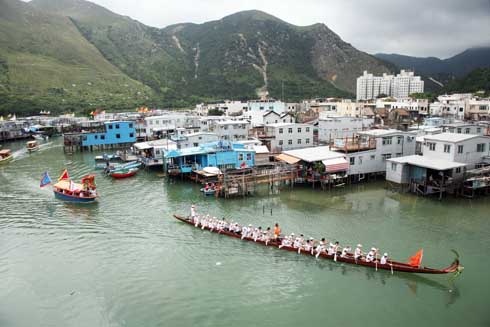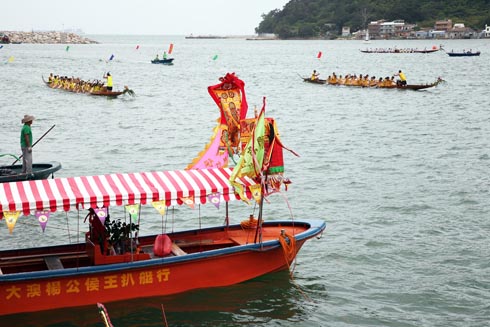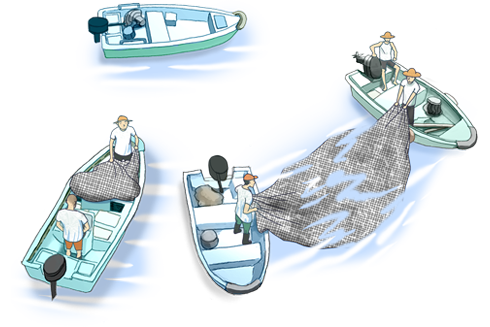The 5th day of the 5th lunar month
The Dragon Boat Festival has a history of 4000-5000 years and its origin was related to sacrifice offering. Different places have their own interpretation but the version of commemorating the poet Qu Yuan was the most widely accepted by rulers over the course of history. Having been passed down through the generations, most of us have forgotten the original significance of the Dragon Boat Festival with only the conventions of Dragon Boat racing and eating rice dumplings preserved. The only exception was the people in Tai O, who still followed the ancient convention of Dragon Boat Water Parade, which was listed for application in the third national list of Intangible Cultural Heritage of China in 2009 by the government of HKSAR and was formally inscribed in 2010 under the approval of Ministry of Culture.
The origin of Water Parade
According to the village elders, the history of Water Parade in Tai O has lasted for a century. It is said that in the early years a plague ravaged Tai O and caused many deaths. In order to drive away the epidemic and blessed the residence with peace and safety, the local people invited the deities from four local temples and settled them on sacred boat, which was dragged by a Dragon Boat and paraded along the waterways and gave offerings all the way through it.
Among a variety of temples in Tai O, which God was of the most significance in the mind of the villagers? It could be told from the order of the entourage. The villagers started from Yeung Hau Temple, followed by Tin Hau Temple, Hung Shing Temple and Kwan Tai Temple. The order was the same when they escorted the God back after the ceremony.
After inviting the God in the morning of the 5th day of the 5th lunar month, the three fishermen’s associations set out for the Water Parade together. According to the tradition, Pa Teng Hong, which had the longest history, led the parade, followed by Yu Yip Hong and Hap Sam Tong. They started from Yeung Hau Temple, took a turn to the Tin Hau Temple and sailed back to Kwan Tai Temple. People sitting in the stern of the sacred boat kept burning joss paper and sprinkling soaked rice as offerings to the spirits wandering in the water. When the sacred boats passed by, residents of the stilt houses also burnt paper gold ingots hoping to dissolve the disasters.
Tai O has a variety of waterways that crisscross one another, but the tributaries have become increasingly narrow. Nowadays the Water Parade is held only in the wide waterways as the residents do not like their huts being hit by the sacred boats and dragon boats. This has shortened the schedule of the whole parade. When the sacred boats came to the Tai Chung Bridge and Sun Ki Bridge, the staff members on the bridge showed their respect by lifting up the bridge to allow passage for the boats. It was the tradition that the god's head should never be pressed or placed beneath people’s feet.
After the Water Parade, the sacred boats belonged to the three fishermen’s associations berthed at their own Dragon’s Base, while the three Dragon Boats in the lead would have a competition show in front of the sacred boats of Pa Teng Hong to please the God. At the same time Dragon Boat Race was held in the same water for entertainment, which was always more competitive and exciting comparatively and therefore more appealing than other activities.
Three fishermen’s organizations, namely the Pa Teng Hong, Yu Yip Hong and Hap Sam Tong, co-organized this activity; they represented the residents from both sea and land. Nowadays many residents of the younger generation have moved to the urban areas to make a living, leading to a recession in the fishing industry. Nevertheless, most of them still come back for the Dragon Boat Festival on the public holiday every year and some even take part in the event to inherit this tradition.
The God Invitation Ceremony started when everything was ready. Boats with deity statues towed by the dragon boats headed to the four temples to invite the gods (Yu Yip Hong and Hap Sam Tong held the event in the morning of the 4th day of the 5th lunar month, whilst Pa Teng Hong starts in the morning on the next day). Before inviting the gods, the person in charge had to ask for god’s permission by offering incense and ask for an answer by throwing Jiaobei. The god's statue would be removed and settled on the sacred boat only if the consent of the god was secured.
Before the parade, participants rowed the Dragon Boats to the abandoned plot of land behind the Yeung Hau Temple. They patted the chopped grass on the Dragons’ head and put it in their mouth to give liveliness to the Dragon Boats. Then they rowed them back to the “Dragon Base” (the temporary shed for gods), where they tied the pomelo leaves on the Dragon’s head and sticked runes on its body. Then began the “Drinking Dragon” ceremony, in which people “cleaned the filth” with paper gold or silver ingots and pomelo leave water, and then a few drops of rooster blood mixed with Chinese white wine was sprinkled on the Dragon Boat, symbolizing the vigorous spirit.








